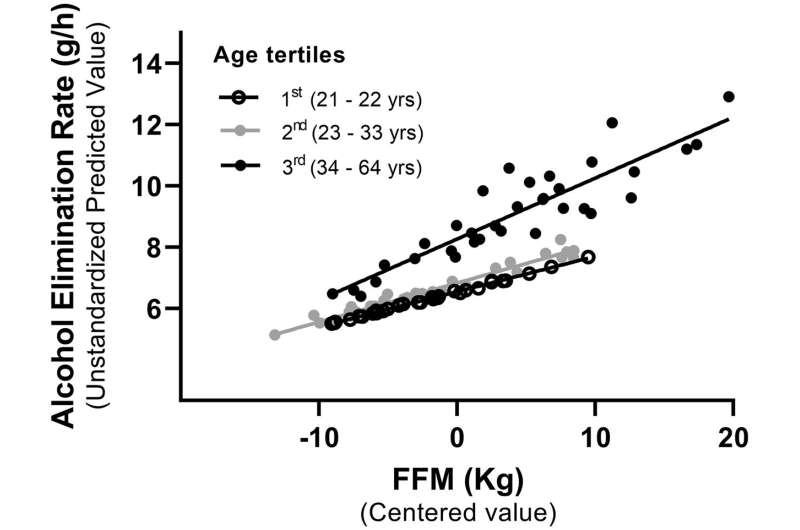This article has been reviewed according to Science X's editorial process and policies. Editors have highlighted the following attributes while ensuring the content's credibility:
fact-checked
trusted source
proofread
Lean body mass, age linked with alcohol elimination rates in women

The rate at which women eliminate alcohol from their bloodstream is largely predicted by their lean body mass, although age plays a role, too, scientists found in a new study. Women with obesity—and those who are older—clear alcohol from their systems 52% faster than women of healthy weights and those who are younger, the study found. Lean body mass is defined in the study as one's total body weight minus fat.
The research is published in the journal Alcohol: Clinical and Experimental Research.
"We believe the strong relationship we found between participants' lean body mass and their alcohol elimination rate is due to the association that exists between lean body mass and lean liver tissue—the part of the liver responsible for metabolizing alcohol," said research group leader M. Yanina Pepino, a professor of food science and human nutrition at the University of Illinois Urbana-Champaign.
To explore links between body composition and alcohol elimination rates, the team conducted a secondary analysis of data from a study performed at the U of I and another at Indiana University, Indianapolis. Both projects used similar methods to estimate the rate at which alcohol is broken down in the body.
The combined sample from the studies used in the analysis included 143 women who ranged in age from 21 to 64 and represented a wide range of body mass indices—from healthy weights to severe obesity. Among these were 19 women who had undergone different types of bariatric surgery.
In a subsample of 102 of these women, the researchers had measured the proportions of lean and fat tissue in their bodies and calculated their body mass indices. Based on their BMI, those in the subsample were divided into three groups: normal weight, which included women with BMI ranging from 18.5–24.9; overweight, those with BMI ranging from 25–29.9; and obese, participants with BMI above 30.
As the researchers expected, women with higher BMI had not only more fat mass than women of healthy weights, they also had more lean mass. On average, the group with obesity had 52.3 kg of lean mass, compared with 47.5 kg for the normal weight group.
The two studies both used an alcohol clamp technique, where participants received an intravenous infusion of alcohol at a rate controlled by a computer-assisted system. The system calculated personalized infusion rates based upon each participant's age, height, weight and gender and was programmed so they would reach a target blood alcohol concentration of .06% within 15 minutes and maintain that level for about two hours
Using a breathalyzer, breath samples were collected at regular intervals throughout the experiments to estimate participants' blood alcohol concentration and provide feedback to the system.
"We found that having a higher fat-free body mass was associated with a faster alcohol elimination rate, particularly in women in the oldest subgroups," said Neda Seyedsadjadi, a postdoctoral fellow at the university and the first author of the study.
"The average alcohol elimination rates were 6 grams per hour for the healthy weight group, 7 grams for the overweight group, and 9 grams for the group with obesity," she said. "To put this in perspective, one standard drink is 14 grams of pure alcohol, which is found in 12 ounces of beer, 5 ounces of table wine or 1.5 ounces shot of distilled spirits."
The interaction between participants' age and lean body mass accounted for 72% of the variance in the time required to eliminate the alcohol from their system, the team found.
Pepino, who also holds an appointment as a health innovation professor at Carle Illinois College of Medicine, has conducted several studies on alcohol response in bariatric surgery patients.
The findings also shed light on alcohol metabolism and body composition in women who have undergone weight loss surgery. Researchers have long known that bariatric surgery alters women's response to alcohol but were uncertain if it affected how quickly they cleared alcohol from their systems.
Some prior studies found that these patients metabolized alcohol more slowly after they had weight loss surgery. The new study's findings indicate that these participants' slower alcohol elimination rates can be explained by surgery-induced reductions in their lean body mass. Weight loss surgery itself had no independent effects on patients' alcohol elimination rates, the team found.
More information: Neda Seyedsadjadi et al, Fat‐free mass accounts for most of the variance in alcohol elimination rate in women, Alcohol: Clinical and Experimental Research (2023). DOI: 10.1111/acer.15047




















